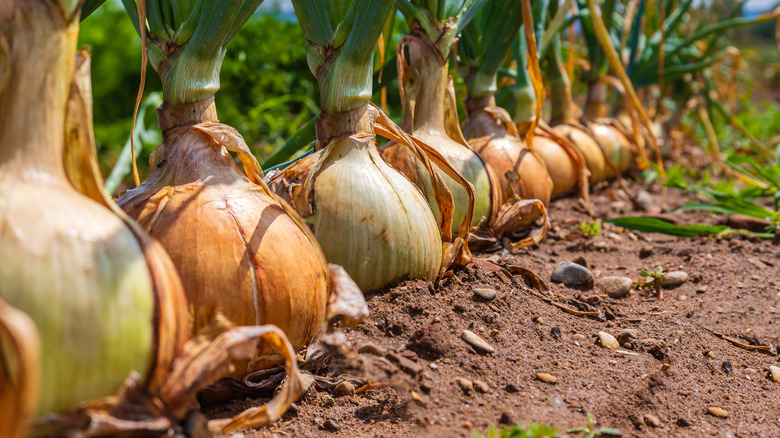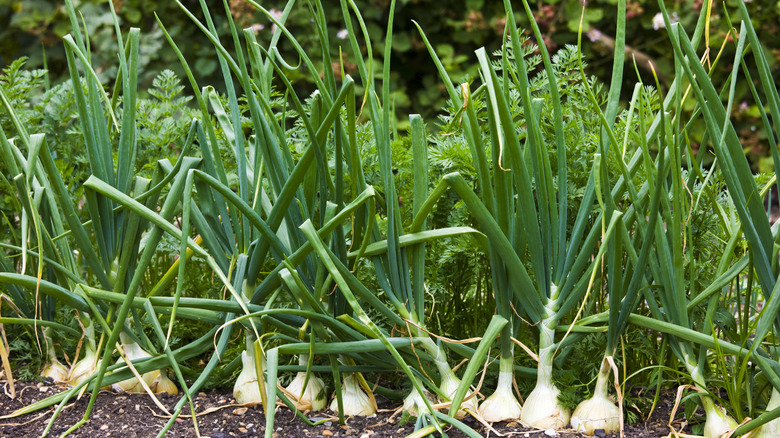The Surefire Way To Tell If Your Onions Are Ready To Harvest
Onions are a garden staple that not only make the perfect addition to various recipes but also have incredible home remedy possibilities — such as cleaning and deodorizing portions of your home. Onions are reasonably easy to grow, needing full sunlight and a pH of 6 to 6.8. They should also be planted as soon as the ground thaws at the start of spring. Depending on the onions you're growing, they can take up to four months to reach maturity. So you can expect to harvest the bulbs sometime in late summer or early fall — and a surefire sign it's the right time is when a majority of your onions' necks soften and droop to the side.
Harvesting your onions on time is essential to their overall quality and how long they will last in storage, but it can be challenging to know when they're ready since they grow underground. It won't be detrimental to pick your onions too early, but you will lose some longevity and flavor. Gathering onions too late, however, can pose risks of rot and sprouting, which will hurt the crop. Even though we cannot clearly see the onion as it grows, we can gather a lot of valuable information about timely reaping by just looking closely at the foliage above ground.
Knowing when to harvest onions
Harvesting onions at the correct time to ensure the fullest and tastiest vegetable relies heavily on reading its leaves. While we know when the crop is estimated to be ready based on when it was planted, it's important not to choose a firm harvesting date in advance. Many things can influence the growth of your onions, especially the weather, so you'll need to carefully watch for some tell-tale signs of growth. It is often said that the perfect onion is ripe when it has grown 13 leaves, which indicates 13 rings. Although there is some truth to this, onions can still be ready with as little as seven.
When the neck of the onion — the space between the leaves and bulb — begins to soften and eventually fall to the side, your onion has reached a good point of maturity. At the first signs of this stage, conduct a mild final watering to sweeten the crop — though some stop watering completely to increase shelf life, which is ideal if you plan on storing the onions. One to two weeks after this point — the last watering, or halt in watering — you'll notice that most of your onions should have those lopsided stems, which means they're in prime condition for picking. To air on the side of caution, also examine the final leaf sheath produced — the most recently grown leaf should be drying up at the time of harvest.
Harvest and storage
How you handle your onions after removing them from the ground is just as crucial as harvesting them at the proper intervals. Harvest onions in the morning before harsh heat and sunlight settle over the day for the best results. As you gather the crop, use a gentle hand and till the soil surrounding it to ensure an effortless extraction. For any onions that are tougher to withdraw, refrain from yanking them out and instead ease them out slowly by continuing to dig around them and pushing them up from the bottom.
To cure onions and prepare them for long-term storage, store them in a dry, dim place with good air circulation and spread them apart. Allow them to dry out for two to three weeks, and then carefully discard any shedding skin and wipe away any leftover dirt. Your onions will then be ready for storage, but you should avoid anything air-tight, like Tupperware or ziplock bags, and keep them out of the fridge unless they have already been peeled. Onions shouldn't be exposed to excess moisture — a common issue with sealed storage or a fridge experiencing condensation. Instead, opt for mesh bags or cardboard boxes. You can even decide to hang them up if that is easiest. Once cured and stored correctly, you can expect typical onions to last up to three months.
Uncured onions are best consumed immediately, and if stored, they should be placed in the refrigerator.

